Director’s Corner
SCIENCE BRIEF
• New Understanding of Nb3Sn Temperature Performance
WORKPLACE LIFE
• Derun Li Moves to DOE
HONORS AND AWARDS
• Director’s Awards for Brouwer, Corlett
• Volunteer Recognition for Reichel, Messe
• Geddes Wins Ray Sydney Award
• Huang, Xu, Persaud ATAP Inventors of Year
• Dragt Honored with Wilson Prize
OUTREACH & EDUCATION
• Summer 2023 Internships
• ATAP, Lab at UCSB Career Day
• Social Media Highlights
IDEA
• The Power of Being an Upstander
• Fabulous Pride Parade Prize
SAFETY: THE BOTTOM LINE
• Safety Week Goes Multi-Lab
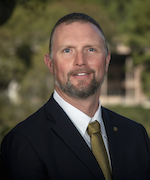
Progress in accelerators has always gone hand-in-hand with progress in the strength, reliability, and cost-effectiveness of magnets. Many of these magnets today are superconducting, and building advanced superconducting magnets requires a close understanding of the properties of the superconducting material. This month’s issue of ATAP News features a Science Brief by Superconducting Magnet Program (SMP) staff scientist Ian Pong, part of a team that has invented a substantially faster and cheaper way to study how the performance of niobium-tin—a material of increasing prominence in particle accelerators and other applications—varies with temperature.
The achievements of ATAP staff have gained considerable recognition lately. The Berkeley Lab Director’s Award for Early Career Scientific Achievement was given to Lucas Brouwer of SMP. Also honored was John Corlett, longtime ATAP researcher and program head who retired recently as head of the Laboratory’s Project Management Office. Corlett won in the category of Organizational Impact. Another member of SMP, postdoctoral scholar Christian Messe, was honored for his work with the Postdoc Association, while Ina Reichel of the Division Office was recognized for outreach work. Longtime ATAP affiliate Alex Dragt received the American Physical Society’s Wilson Prize. Derun Li, on retiring from ATAP, is taking on an important new role at DOE HEP.
Safety is the basis of everything we do in ATAP. Along with the Engineering Division and the ALS-U Project, we held our annual Safety Week October 31 through November 4. It’s too good an idea for just one lab, and this year, in an effort led by Asmita Patel, we participated in the first-ever multi-lab Safety Week. Fermilab and Brookhaven groups that work closely with our Superconducting Magnet Program (SMP) as part of the Large Hadron Collider High Luminosity Accelerator Upgrade Project participated simultaneously and contributed to informative seminars on topics that included occurrence reporting, safe lifting and other materials handling, and occurrence reporting. Besides these opportunities to learn from experts, participants cleaned and organized their workspaces and got ahead on their training requirements. This investment of about a day’s effort (spread over the course of the week), which is less than 0.5% of the work year, always pays ongoing dividends in safety and efficiency. Many findings were addressed on the spot; I encourage everyone to follow up on the outstanding action items.
Finally, I would like to welcome a new voice to ATAP News and our other communications. Carl Williams, our new Science Writer/Editor, started his academic life as a physicist and holds a bachelor’s degree in physics and a master’s degree in radiation physics. After earning a PhD in analytical chemistry from the University of Surrey, he embarked on a career as an energy, climate change, and sustainability consultant, working in his native UK, India, Ireland, Australia, and Canada. He has also worked extensively as a freelance science writer, publishing articles on a broad range of topics for the Nature portfolio of academic journals and magazines. His diverse publications have many adjacencies and intersections with ATAP’s research, and we look forward to exploring how he can help us communicate our achievements.
SCIENCE BRIEF
A Procedural Solution for Determining the Temperature Dependence of Nb3Sn Superconductor Performance
by Ian Pong
Superconductors convey electrical current with essentially no resistance. This capability is used primarily to make powerful electromagnets, which are key to applications ranging from high-energy physics to magnetic resonance imaging to fusion energy. Understanding how their performance varies with temperature is an important part of advancing these applications. An international team that includes a researcher in ATAP’s Superconducting Magnet Program has found a more accurate way to characterize performance across a range of temperatures using the quicker, easier, less expensive “magnetization” technique. Their approach uses one standard current-transport measurement as the “anchor” for a data set composed mostly of considerably easier magnetization measurements.
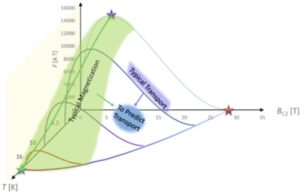
Superconducting magnet materials work within certain combinations of the current (in the figure the vertical axis shows the “pinning force” (the product of the critical current and the magnetic field) that they carry; the applied magnetic field; and the temperature. Ways of measuring their performance include measuring the current that they actually transport (purple), and the quicker, easier approach of measuring magnetization (green), but neither method alone using standard specialized equipment gives a complete predictive assessment of transport performance in accelerator magnets for high energy physics (blue). The authors explain the basis for differences in the two types of methods, and outline a way to use one transport measurement as the “anchor” for a series of magnetization measurements.
Each material is superconductive only below a certain “critical temperature” or Tc. There are two other such critical parameters: the current density in the wire, Jc, and the upper limit on field strength Bc2. These three parameters are interrelated in a way that can be described by a “critical surface” in a 3D plot. (Note that in the figure, Jc is replaced by the pinning force F which is the product of Jc and B.) The penalty for violating these limits is that the wire becomes normal-conducting, and the vast current it carries, suddenly facing a resistive load, turns into heat—which is very undesirable inside a deeply cryogenic magnet with a large amount of stored energy.
Jc and Bc2 are at their maximum at absolute zero (superconducting magnets typically operate not far above this point; the Large Hadron Collider, for instance, runs at 1.9 kelvin) and vanish at Tc. At no point in that operating space may any of those parameters may be exceeded. Knowing the temperature dependence of a superconductor’s performance is critical in superconducting magnet design because it gives the temperature margin for safe operation.
For perspective, a wire made of niobium-three-tin (Nb3Sn), a high-field material beginning to be used in particle accelerators, with a cross sectional area of just 1 mm2 can carry well over 1,000 A at liquid helium temperatures (4.2 K) amid a magnetic field of 12 tesla (several hundred thousand times the Earth’s magnetic field strength). For comparison, a familiar normal-conducting, room-temperature wire—the conductor in the power cord of a TV set—with a 2 mm2 cross section might be rated at about 10 A.
The most difficult situation is measuring the limit of a superconductor’s current-carrying ability at temperatures above 4.2 K. Magnet developers need to explore this part of the Tc, Jc, Bc2 parameter space depicted above in order to understand the temperature margin, even though the magnet will be operated at lower temperatures. However, measurements above this temperature involve gaseous helium, which has lower cooling capacity than liquid helium. Therefore, fully and accurately characterizing the temperature dependence of any high-current, high-field superconductor’s performance requires world-class experts with specialized equipment.
It is an expensive endeavor. Mapping the Jc dependence of a piece of wire over a moderate range of magnetic fields and temperatures with the gold-standard transport technique takes days and can cost tens of thousands of dollars. Instead of transport measurements, where one passes a large current through the superconductor and measures the voltage, the new approach uses one such measurement as an anchor for a series of magnetization measurements, which are much easier and cheaper, using a vibrating sample magnetometer (VSM) or superconducting quantum interference device (SQUID).
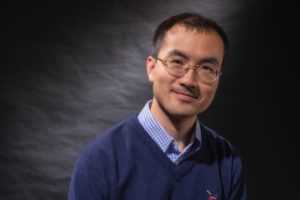
Ian Pong, lead author of the paper. [Thor Swift/Berkeley Lab)
Magnetization measurements use comparatively short samples, can be performed in a matter of hours, and cost only a tenth as much as transport measurements. The parameter space in which they work is complementary to that of transport measurements. But there is a catch: the temperature dependencies of a given Nb3Sn wire determined by the two measurement methods don’t always match.
In a recent paper published in the journal Superconductor Science and Technology, Pong (the lead author) and colleagues from NIST, ATI Vienna, CERN, and the National High Magnetic Field Laboratory identify the issues underlying this discrepancy in temperature dependence measurements and propose a procedural solution for reconciling the temperature dependence difference in NbcSn superconducting wires. By taking one standard transport measurement at 4.2 K as an ‘anchor’, with this procedural solution it becomes possible to combine the simplicity and economy of quick magnetization measurements at different temperatures with the accurate prediction of transport properties in extrapolated temperature ranges.
The work has led to a new understanding of the reasons why transport and magnetization techniques give different readings, so that the respective strengths of these methods can now be combined. During the peer review process, the journal commented that “This manuscript may be a definitive article on the temperature scaling law of critical current in Nb3Sn superconducting wires.”
WORKPLACE LIFE
BACI Program Head Derun Li Retires, Takes Management Role at DOE
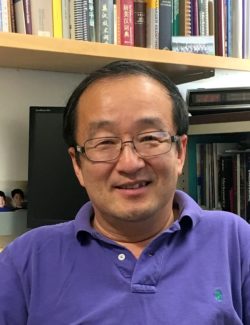
Derun Li
Derun Li, Senior Scientist and head of our Berkeley Accelerator Controls and Instrumentation (BACI) Program, retired from Berkeley Lab on October 31st, 2022.
Derun will soon begin a full-time encore career with DOE’s Office of High Energy Physics (OHEP). There he will succeed L.K. Len as head of the General Accelerator R&D Program, a crucial program developing the new accelerator methods that enable the next generation of projects and future particle colliders. Derun has been a part-time detailee to OHEP for the past year.
In 2017, after three years as its deputy, Derun became head of the BACI Program—a successor to the Center for Beam Physics, where he started his Berkeley Lab career. He has led the program in developing new controls and instrumentation, which increasingly drive the capability of complex accelerator systems. This includes world-class programs in feedback and machine learning controls across a variety of application areas including accelerators; low-level RF; laser pulse combining; quantum information science; advanced RF structures, including those in strong magnetic fields; and novel beam sources and diagnostics. The Division is starting an international search for the next head of this exciting and vital program.
Derun arrived at Berkeley Lab in 1997 after earning his doctorate under the renowned S.Y. Lee at Indiana University in 1995, followed by a postdoctoral appointment under Professors S. Schultz and N. Kroll at the University of California-San Diego. Joining the Center for Beam Physics, he developed innovative radiofrequency systems for some of the most challenging efforts of their times, including the Advanced Light Source, the PEP-II B-meson “factory” at SLAC, and free-electron laser proposals, as well as design studies for components of the Large Hadron Collider at CERN and the Relativistic Heavy Ion Collider at Brookhaven.
He managed the Lab’s Muon Accelerator Program, leading the US teams for normal-conducting RF cavity R&D for muon ionization cooling channels. The UK-based Muon Ionization Cooling Experiment (MICE) was another key area of contribution to a future muon collider. Collaborating with Oxford University, he led the development of a novel RF cavity design with thin beryllium windows for MICE, along with superconducting solenoidal coupling coils. Derun also headed the LBNL team for spectra-solenoidal magnets. A landmark paper describing a successful ionization-cooling demonstration appeared in Nature in 2020.
Derun also led the development of high performance radiofrequency-quadrupole linacs (RFQs). This type of accelerator is especially well suited to being an injector for the highest-quality low-energy protons and ions in an accelerator complex, but poses a number of unique design and implementation challenges.
Derun’s success with RFQs began with a design study for a spare for the Spallation Neutron Source, which is now a major DOE neutron science user facility at Oak Ridge, and culminated in PIP-II, the Proton Improvement Plan at Fermilab. He led the LBNL team that designed, constructed and delivered Berkeley Lab’s first continuous wave (CW) RFQ to PIP-II. The PIP-II RFQ has been successfully commissioned (exceeding its design performance) and is presently the injector of the PIP-II accelerator complex—the future of high-energy physics in the US, helping enable Fermilab’s high-intensity neutrino physics program.
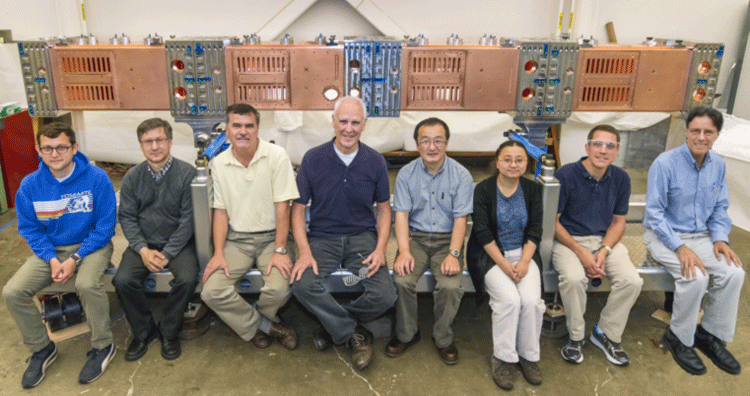
The PIP-II RFQ team: left to right, LBNL engineers Andrew Lambert and Matt Hoff, lead engineer Steve Virostek; ATAP physicists
John Staples, Derun Li (principal investigator), and Tianhuan Luo; Fermilab engineer James Steimel, our technical contact there;
and LBNL engineer Allan DeMello.
Continuing his technical as well as his leadership contributions, most recently he has headed the Berkeley Lab team for the development of APEX-II, which will be the next generation of the highly successful Advanced Photoelectron Experiment (APEX). Derun had earlier worked on rf-cavity studies for APEX and the APEX-based injector for the LCLS-II at SLAC. APEX has also led to a state of the art facility at BACI for photoinjector, beam and diagnostic development and for Ultrafast Electron Diffraction, known as HiRES. Since 2019, he has been the senior team leader and PI at Berkeley Lab overseeing the ongoing collaborations with SLAC on LCLS-II and LCLS-II HE.
Please join us in congratulating Derun on 27 years of technical and leadership contributions to some of our most challenging and important work, and wishing him the best in his new role of shaping and supporting research toward the next generation of accelerators.
HONORS AND AWARDS
Director’s Awards for Lucas Brouwer, John Corlett
Lucas Brouwer, a research scientist in ATAP’s Superconducting Magnet Program, has been recognized with the 2022 Berkeley Lab Director’s Award for Exceptional Achievement in the category of Early-Career Scientific Achievement.
Also honored was John Corlett, who retired recently as head of the Laboratory’s Project Management Office and was previously a program head and project leader in ATAP. Corlett won in the category of Organizational Impact.
The awards were announced October 19 and presented in a hybrid in-person and virtual ceremony Thursday, November 10.
Lucas Brouwer
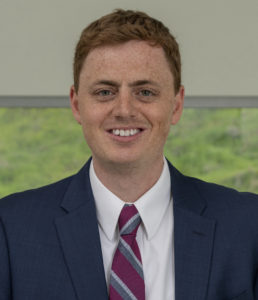
Lucas Brouwer
“For achievements in superconducting magnet science and applications, including seminal work in a new superconducting magnet geometry being applied to high-energy physics and cancer therapy, and for developing a key enabling technology for the 1K-TEM Project.”
Lucas Brouwer’s award citation includes varied and far-reaching accomplishments in magnets for particle accelerators. He established the analysis tools and design process for the Canted Cosine-Theta (CCT) geometry for high-field particle-accelerator magnets, and has become a leader in their application in both high-energy physics and ion-beam cancer therapy. Meanwhile, Lucas’s work on a superconducting magnet for electron microscopy culminated in the fabrication and successful test of a prototype superconducting electron lens for the superconducting electron microscope under development within the 1K-TEM project. His development has the potential to have large impacts in many fields employing ultra-stable superconducting magnets, such as MRI/NMR, precision mass spectroscopy, and quantum information science.
Lucas’s thesis work described the advantages of CCT magnets, a geometry which, at that time, was not being seriously considered for high field magnets. He has since led the rapid development of the technology for high energy physics and medical therapy applications. Lucas led the design of a series of CCT dipole magnets at LBNL, which resulted in the formation of CCT research programs both within the US and internationally. Most notably, the DOE-HEP US Magnet Development Program (US-MDP) now includes several CCT programs, as do both CERN and the Paul Scherrer Institute. Recently, CERN selected a CCT design for the orbit correctors required for the High-Luminosity Upgrade of the LHC (which will be the first CCT magnets installed in an operating collider).
It took less than 10 years from his seminal doctoral thesis to fabrication of superconducting CCT magnets for an operating accelerator. The concept’s rapid maturation—arguably unique in the history of accelerator magnets—is in part driven by the strong conceptual underpinnings that Lucas developed.
In particular, his comprehensive mathematical treatment of both straight and curved CCT magnets laid the foundation for the concept’s development at many laboratories around the world, and serves as a benchmark for others working on the technology. The CCT concept is unique in magnet designs in the sense that it is intrinsically “3D” and hence requires a more sophisticated approach to its analysis, both in terms of electromagnetics and in terms of its mechanical response and behavior when energized. Magnets such as the CCT are designed to transport beams of charged particles, effectively serving as optics. Brouwer led the development of techniques that combine the magnetic design and analysis with the optics analysis to optimize beam transport characteristics for various applications.
Building upon these achievements, Lucas also has a significant record of accomplishments in superconducting magnets for ion beam cancer therapy. The need for changes in beam energy during patient treatment has been one of the primary technical obstacles to taking advantage of the strength of superconducting magnets in this field, because it is harder to change magnetic field when using superconducting magnets. Lucas co-invented the Alternating Gradient Canted-Cosine-Theta (AG-CCT) design, patented by Berkeley Lab, which achieved a momentum acceptance (ability to handle different energies without changing magnetic field) of ~30%, compared to the 3% of previous approaches.
Recently, Lucas conceived of a new superconducting magnet layout with an even larger momentum acceptance, allowing the transport of the full range of proton energy used for these treatments (70-230 million electron-volts) without field change in the superconducting magnets. This is a breakthrough in technology for proton therapy, and has far-reaching implications for other accelerators that benefit from large momentum acceptance. Over the past year, as a part of a DOE HEP Stewardship project, Lucas led the effort to design the first High-Temperature Superconductor, fixed-field magnet for proton therapy, a significant step towards demonstrating the concept.
Proton therapy is a rapidly growing treatment modality for a variety of cancers, and already represents a ~$0.5B market worldwide, with rapid growth anticipated in the years ahead. Impressively, Lucas contributes critically on all aspects of the CCT concept, from magnet and optics design to the fabrication and testing of prototypes—all while collaborating with and leading teams of scientists, engineers, and technical staff from multiple international organizations.
Another kind of accelerator: the electron microscope
Over the last year, Lucas’s work on a superconducting magnet for electron microscopy culminated in the fabrication and successful test of a prototype superconducting electron lens. This significant achievement demonstrates a key technology for the superconducting electron microscope under development within the 1K-TEM project, whose goal is a highly stabilized transmission electron microscope operating at temperatures around 1 kelvin—near absolute zero. As part of this effort, Lucas developed a new method for active stabilization of superconducting magnets operating in persistent current mode (provisional patent filed), and demonstrated its effectiveness by stabilizing the field in the electron lens. This method shows development potential for stabilizing fields at the parts-per-billion level, which has the potential to have large impacts in many fields employing ultra-stable superconducting magnets, such as MRI/NMR, precision mass spectroscopy, and quantum information science.
John Corlett
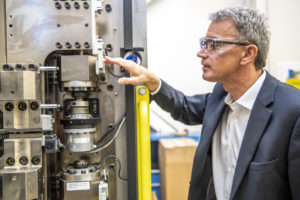
Corlett examines the actuating mechanism of an undulator (a magnetic array that makes the electron beam in a free-electron laser emit photons) for LCLS-II. (Credit: Marilyn Sargent/Berkeley Lab)
Citation: “For his deft management and oversight of the Lab’s growing project portfolio, and for his sustained contributions to the Lab’s project management and delivery capability, and in particular for his successful stewardship of high-profile scientific projects.”
John came to Berkeley Lab in December 1991 after several years at Daresbury Laboratory—an accelerator lab in the UK—and three years in the private sector. His expertise in radiofrequency techniques was a good match for the design and construction of the Advanced Light Source storage ring and commissioning phase of the booster, and his original intent was to stay two years for that purpose.
This intention, in hindsight, stood little chance against the exciting things that were going on in the Accelerator and Fusion Research Division, as ATAP was then known. Corlett worked in the Center for Beam Physics, which had just been organized by Swapan Chattopadhyay, based on the Exploratory Studies Group and chartered as a central resource for the Division where theory and experiment (including a thriving group specializing in beam electrodynamics) could come together to incubate ideas. In CBP, Corlett was part of a cohort of future leaders gathered together at an exciting time for accelerator physics.
As the ALS was commissioned, PEP-II, the energy-asymmetric B-meson factory at SLAC, was getting underway. Berkeley Lab had principal responsibility for the technically challenging low-energy ring of the B factory. The experience of the ALS and PEP-II led to work on damping rings for the SLAC-led proposal for a Next Linear Collider and, later, its technically rather different successor, the International Linear Collider. Neither of those efforts have come to fruition yet (though ILC work continue to this day), but in a running theme of Corlett’s career, every accelerator, realized or not, is a learning experience that informs and improves future designs. One spinoff of these efforts was the development of accelerator technologies that underlie the free-electron laser facilities of today.
Corlett was by then expanding his skillset into technical management, serving for several years as head of the Center for Beam Physics under Bill Barletta and then as Deputy Director of the Division for Steve Gourlay.

Corlett in 2006, heady times for free electron lasers. (Credit: Roy Kaltschmidt/Berkeley Lab)
A series of Berkeley Lab proposals for FEL facilities—LUX and then the Next-Generation Light Source—did not progress to funded projects, but yet another SLAC collaboration ensued: the multi-institutional Linac Coherent Light Source-II project. Several institutions contributed their expertise to this project, which is nearing completion.
These are just a few examples of how, over the course of his career at the Lab, John mastered the art of collaboration with other scientific institutions. Combining this with his experience of project leadership, as well as the research and user community consensus building that leads to Department of Energy program development, he embarked upon a new phase of his career as a project-management professional. Moving from ATAP to the Laboratory Directorate, he served as deputy to Kem Robinson, head of the Project Management Office, and subsequently led the office after Robinson’s retirement.
His stewardship of the Project Management Office has further developed and strengthened this critical Lab function. In addition to managing the PMO team, John shepherded and assisted a range of complex and critically important projects. including CMB-S4, ALS-U, ESnet 6, and BioEPIC. For CMB-S4, John served as Interim Project Director during a key initial period for the project. He was a critical part of the effort to develop and hone the Lab’s project management capabilities, including two Project Management Advisory Boards (PMABs), which provided assurance and assistance to major mission-critical science and infrastructure projects. Last year, John and his team hired two deputies: Emil Nassar for Science and Engineering projects and Piper Kujac for Construction and Infrastructure projects.
This story incorporates elements of a Project Management Office-focused appreciation of John Corlett’s career by Berkeley Lab Director Mike Witherell, Deputy Director for Research and Chief Research Officer Carol Burns, and Deputy Director for Operations Michael Brandt.
ATAP’s Ina Reichel, Christian Messe Honored at Volunteer Appreciation Day
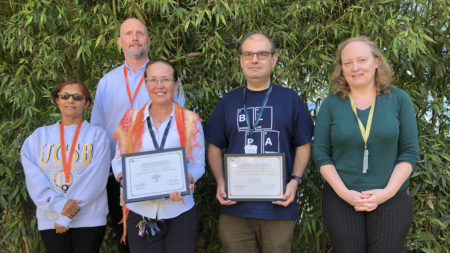
L-R: ATAP Deputy Division Director for Operations Asmita Patel, Division Director Cameron Geddes, Outreach and Education Coordinator Ina Reichel, Superconducting Magnet Program postdoctoral scholar Christian Messe, and ATAP administrator Michele Pixa at Volunteer Appreciation Day. Reichel was honored as a STEM Ambassador, Messe for his work on behalf of the Postdoc Association.
Many people at Berkeley Lab go the extra mile for something they believe in. On September 21, the Lab celebrated their efforts with Volunteer Appreciation Day.
The event was organized by the K-12 Program in the Lab’s Workforce Development and Education Office.
Ina Reichel, Outreach and Education Coordinator in the ATAP Division Office and a member of the Advanced Light Source communications team, was one of six Lab employees honored as a STEM Ambassador. She has long been a mainstay of such outreach events as Daughters and Sons to Work Day, Nuclear Science Day for Scouts, and Oakland Unified School District events like Science Fair and Dinner with a Scientist.
Reichel also leads tours of the ALS. This summer, as part of the Science Accelerating Girls’ Engagement in STEM (SAGE) program, she led tours of the Advanced Light Source and helped organize the job shadowing that is a key part of the SAGE experience.
Christian Messe, postdoctoral scholar in our Superconducting Magnet Program, was honored for his contributions to the Berkeley Lab Postdoc Association. He chairs their social committee, one of several Postdoc Association efforts to improve the lives of our postdoctoral scholars both on and off duty. “It can be hard to find work/life balance and develop a social life, especially for people from other countries and cultures,” said Messe. Under his leadership (“with the help of a lot of hardworking volunteers,” he adds), the committee arranged social events ranging from monthly pub nights to hikes, as well as day trips to Yosemite National Park (attracting more than 35 participants from across the Lab) and Pinnacles National Park. Taking advantage of California’s promisingly early snow season, a ski trip is now being organized.
“Ina and Christian exemplify the spirit of volunteerism that I am proud to see widely in ATAP,” said Division Director Cameron Geddes, adding, “I encourage all of my colleagues to give generously of their time and special expertise.”
Three ATAP People Tied for “Inventor of the Year”
Berkeley Lab’s Innovation and Partnership Office (IPO) has honored three researchers as ATAP Inventors of the Year. Gang Huang and Yilun Xu tied with Arun Persaud for the most invention disclosures of the year.
Gang and Yilun, who work together in the Berkeley Accelerator Controls and Instrumentation Program, have been working principally on applying their accelerator-controls expertise to various challenges in quantum computing. Arun’s R&D activities prominently include the use of neutrons to measure carbon stored in soil.
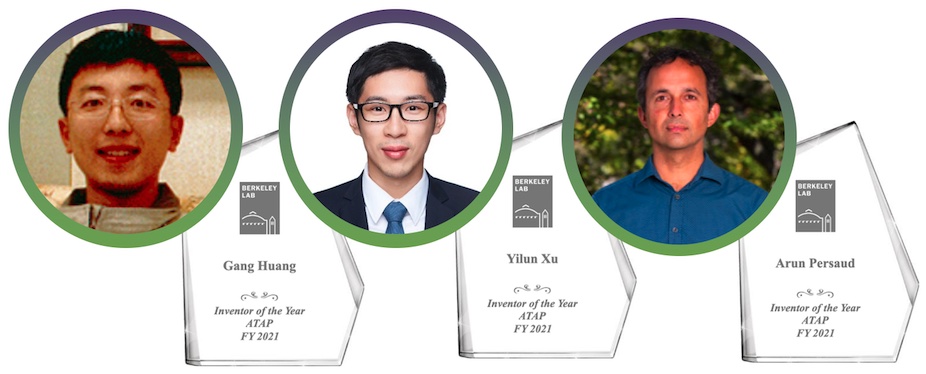
Inventiveness recognized: left to right, Gang Huang, Yilun Xu, and Arun Persaud
APS Wilson Prize Honors Alex Dragt
By Robert Ryne*
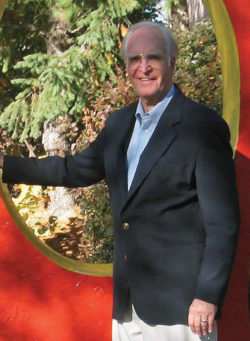
Alex Dragt ca. 2014. Photo courtesy Spark, the Calvin University Magazine
The 2023 Robert R. Wilson Prize for Achievement in the Physics of Particle Accelerators has been awarded by the American Physical Society (APS) to Alexander J. Dragt, Sr. He received the honors “for pioneering contributions to the development and application of Lie methods in accelerator physics and nonlinear dynamics.”
Alex is emeritus professor in the Department of Physics and Astronomy of the University of Maryland, College Park. He has also had a long affiliation with the University of California and Berkeley Lab. He received his Ph.D. in theoretical physics from UC Berkeley in 1964, studying under Robert Karplus.
During his career Alex was twice a visiting staff member at Los Alamos National Laboratory, then operated by UC. He was a Guest Scientist at the Superconducting Super Collider Central Design Group in 1985 when it was located at Berkeley Lab. He was an affiliate for many years in the ATAP Division and its predecessor AFRD. Several of his doctoral students went on to become staff members at Berkeley Lab, including present staff Chad Mitchell and Marco Venturini and former staff David Douglas (retired from Jefferson Lab), Etienne Forest (KEK), and the author.
Among his many professional activities, Alex has chaired the Executive Committee of the American Physical Society Division of Physics of Beams. He has served on many government committees, including the High Energy Physics Advisory Panel (HEPAP), the DOE Committee on High Performance Computing, and the DOE Advisory Panel on Accelerator Physics Computer Codes.
Starting in the 1970s, Alex and his students developed new mathematical and computational tools for modeling dynamical systems including beam dynamics in accelerators. He championed the use of transfer maps in accelerator physics, work that was recognized by a 2013 IEEE Particle Accelerator Science and Technology award. The use of transfer maps led to new methods to characterize, design, analyze, and optimize dynamical systems.
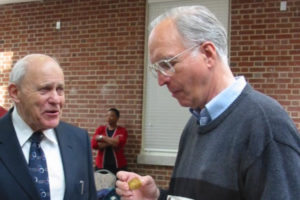
Alex (right) with John Toll, physicist and head of the University of Maryland System. Photo courtesy UMD.
Alex was among the first to emphasize the importance of simulating Hamiltonian systems with tools that maintain the symplectic condition. In 1976 Alex and a graduate student, John M. Finn, developed a method for describing symplectic maps as a factored product of Lie transformations, and published what is now known as the Dragt-Finn factorization theorem. This led to the first beam dynamics code based on Lie algebraic methods, MaryLie. The Lie polynomials in the factored product representation are directly related to aberrations in single-pass systems.
Alex and his students also developed normal form techniques that are crucial to the analysis of long-term dynamics in circular accelerators. Other important developments included new methods for symplectic tracking, as well as techniques for modeling magnets and RF cavities with realistic fringe fields. Alex was also among the earliest beam physicists to espouse the concept of eigen-emittances and to develop numerical methods for their computation.
Alex continues to work on his book Lie Methods for Nonlinear Dynamics with Applications to Accelerator Physics, which can be downloaded for free. The roughly 3000-page book contains considerable background material, along with a very substantial portion—developed by Alex himself and in collaboration with his students—devoted to applications in accelerator physics.
The mathematical and computational methods pioneered by Alex, and developed by him along with his students and collaborators, benefit every new design of a major accelerator today. His emphasis on tools that enforce the symplectic condition had a huge impact on the prediction of long-term dynamics in circular accelerators, and his focus on transfer maps led to new techniques for beamline analysis and optimization. The Lie-algebraic representation of maps has led to new ways to characterize the nonlinear content of dynamical systems in general.
The implications of this work extend far beyond particle accelerators. These methods have applications not only to accelerator physics, but also to electron microscopy, geometric light optics, and plasma physics. ATAP extends its congratulations to Alex on the well-deserved honor of the 2023 Wilson Prize.
*ATAP retiree Robert Ryne headed the Accelerator Modeling and Advanced Computing Group in the Center for Beam Physics.
Cameron Geddes Receives Hertz Foundation Ray Sydney Volunteer Leadership Award
ATAP Division Director Cameron Geddes was honored with the Raymond Sydney Volunteer Leadership Award by the Fannie and John Hertz Foundation. The award recognizes outstanding volunteers for their generous personal and/or financial contributions to building the Hertz community.
He and 2022 co-honorees Professor Shannon Yee of Georgia Tech and Professor Jessica Seeliger of Stony Brook University were cited for their “immense and inspiring service to the Fellowship and Programs Council.”
“I am very honored to share this award with Jessica and Shannon, who are two of the people in the foundation I most admire for their efforts,” Cameron said.
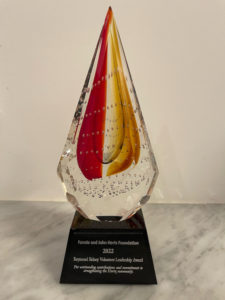
Each winner received a certificate and a statue shaped like a flame, symbolizing “their work to ignite the community.”
The awards ceremony noted that “Over the years, these three have led countless events, championed community causes, spearheaded initiatives and processes, nurtured the community, resolved conflict, and have passed that torch to the next generation… They are jointly deserving because of the cumulative contributions of their collaboration to grow and nurture the community over the last decade plus.” It went on: “They have demonstrated that their collective contributions are greater than the sum of their parts, which is an exemplary hallmark of what this volunteer leadership award embodies.”
Cameron entered the Hertz community in 2000 with a Hertz Graduate Fellowship at the University of California-Berkeley and was honored with the Hertz Thesis Prize in 2005.
OUTREACH AND EDUCATION
Internship Programs Open for Summer 2023

Internship programs are not tied to specific openings in ATAP, but we often host participants. The various programs listed on the Berkeley Lab Workforce Development and Education Office website offer many opportunities throughout the Lab and the DOE research complex. Participation in programs like these is part of many a STEM career journey and a great way to explore national-lab opportunities. Applicants who are specifically interested in ATAP are invited to let us know in addition to submitting an application to the program.
We also welcome graduate students under the DOE Office of Science Graduate Student Research (SCGSR) program and welcome you to reach out about opportunities.
Has reading about our research made you want to join us in a career position We have staff (including Program Head) and postdoctoral openings as well.
The following internship programs are especially ATAP-relevant and currently accepting applications.
Summer Undergraduate Laboratory Internship (SULI) Program
The U.S. Department of Energy’s (DOE) Science Undergraduate Laboratory Internship (SULI) program encourages undergraduates from two- and four-year colleges, post-baccalaureates, and graduate students to pursue STEM careers by providing research internships at one of 17 DOE National Laboratories. The application deadline for Summer 2023 SULI internships is January 10, 2023 (there are also Fall and Spring SULI internships).
Community College Internship Program
The Community College Internship (CCI) program seeks to encourage community college students to enter technical careers relevant to the U.S. Department of Energy (DOE) mission by providing 10-week internships at one of 15 DOE laboratories. Learn more about the program. The application deadline for the Summer 2023 internships is January 10, 2023.
GEM Fellowship (for graduate students)
The GEM program at Berkeley Lab is open to GEM fellows at the master’s and doctoral levels. It aims to cultivate a diverse workforce in the next generation of scientists and engineers. The GEM program specifically recruits African American/Black, Hispanic American/Latino, and American Indian/Native students. GEM fellowships are individually tailored and typically begin by reaching out to a specific researcher. The deadline was November 15, 2022 for the current cycle, so this is a good time to lay the groundwork for an upcoming GEM cycle.
Visiting Faculty Program (for college faculty)
The Visiting Faculty Program (VFP), formerly called Faculty and Student Teams (FaST), is intended to support the professional development of current faculty members who want to increase their independent research’s competitiveness through scientific research collaborations with U.S. Department of Energy (DOE) laboratory scientists. Applying faculty members may optionally invite up to two student participants from the faculty member’s home academic institution, one of whom may be a graduate student. The application deadline for the Summer 2023 cycle is January 10, 2023.
Representing ATAP and Berkeley Lab at UCSB Chemistry’s Career Day
Asmita Patel, ATAP Deputy Division Director for Operations, was among the participants in Chemistry and Biochemistry Career Day at the University of California-Santa Barbara. The September 16 event featured career-oriented panel discussions, technical poster sessions, and networking opportunities with employers.
It was familiar ground for Patel. After earning her doctorate in molecular biology at UC-Riverside, she was a postdoctoral scholar at UCSB, and has maintained ties with the school through her subsequent career in biotech and then Berkeley Lab.
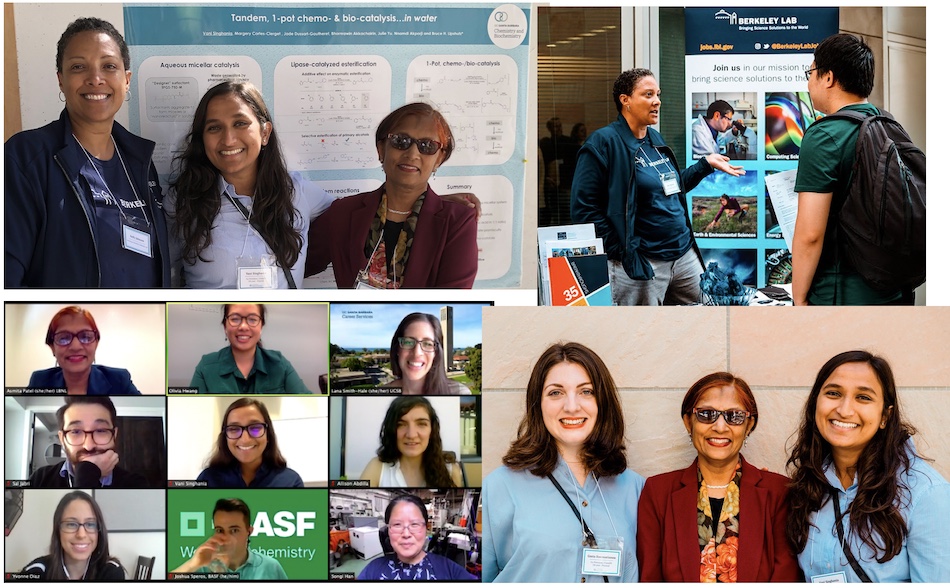
Top left: from left to right, Kelly Johnson, manager of Berkeley Lab’s Talent Outreach Program; Vani Singhania, UCSB doctoral candidate in organic chemistry and co-president of ChemPD, a professional development organization for chemistry and biochemistry at UCSB; and Asmita Patel in front of Singhania’s poster. Top right: At the Berkeley Lab booth, Talent Outreach Manager Kelly Johnson discusses career opportunities with a UCSB student. Bottom right: From lert to right, chemistry PhD candidate and ChemPD co-president Greta Koumarianou, Asmita Patel, and Singhania. Bottom left: Now held in person once again, the event had been held virtually during COVID times.
ATAP Social Media Highlights
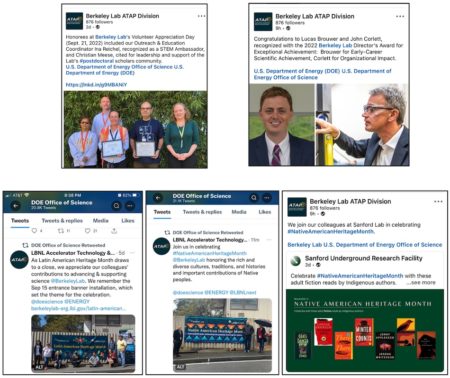
You heard it here first
Celebrating the achievements and honors of our staff is a prime use of ATAP’s social media presence. This issue of the newsletter has details on news we broke on social media: Volunteer Appreciation Day recognition for Ina Reichel and Christian Messe and Berkeley Lab Director’s Awards for Lucas Brouwer and John Corlett.
We’re proud of how many ATAP social media postings are relayed by important stakeholders like the DOE Office of Science. In turn, we seek out and amplify the thoughts of others throughout the world of science that are aligned with our values and interests.
Join us on LinkedIn and Twitter to always get the latest!
INCLUSION, DIVERSITY, EQUITY AND ACCOUNTABILITY (IDEA)
Upstanding: Immediacy Is One of its Strengths
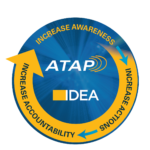
We’ve probably all heard of “upstanding”—intervening when someone is being hurtful to others. But does it really apply to such educated and high-minded folk as scientists, and in Berkeley, no less? A recent report reminds us that we are human and imperfect and indeed it does.
Sara Reardon’s article “Don’t walk on by: how to confront bias and bigotry aimed at others” appeared as a Career feature in the journal Nature. Reardon cites, among other things, a landmark 2018 National Academies report on sexual harassment in the sciences. The National Academies report called for more bystander training in scientific workplaces, as research suggests that such bystander-to-upstander programs can improve the likelihood that bystanders will intervene.
Nature has also recently published a special issue focused on racism in the sciences. It includes stories that make for dismaying and sometimes downright harrowing reading… but seeing where we are is how we can plot a course forward.
Upstanding addresses an identifiable, insidious problem. It not only defends the victim of a biased act or statement, but also helps the rest of us learn and improve along our IDEA journeys. It is also a uniquely effective complement to institutional means of responding to problems.

Immediate and personal feedback can solve problems where institutional measures have difficulty reaching
Saying almost anything constructive is better than the implicit approbation of silence. “If no one ever speaks up or disagrees publicly, then targets learn that we tolerate and accept those moments of bias,” Stephanie Goodwin, a social psychologist at Wright State University, says in Reardon’s article.
(Goodwin’s statement is ancient wisdom. “Qui tacet consentire videtur,” observed Renaissance intellectual Thomas More (at least in A Man for All Seasons). “Silence is tacit consent.”)

Not just a Berkeley Lab stewardship value, but a basic human responsibility
Our responsibilities to the values of science, to the people, and to each other—in short, our stewardship values—require it. Let’s hope that situations requiring upstander behavior are few and far between, but when they occur, let’s not be mere bystanders.
To learn more…
The training materials available at the Lab’s IDEAs In Action website are an excellent start on this aspect of one’s IDEA journey.
A Fabulous Result for Berkeley Lab Pride Parade Contingent
From Elements, the Berkeley Lab newsletter
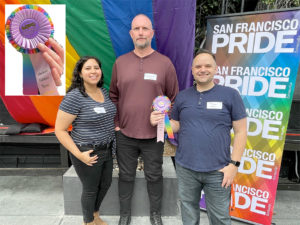
L-R: Joselyn Delgado, Cameron Geddes, and Tom Gallant accept the Absolutely Fabulous Theme Contingent award on behalf of the Lab’s Pride Parade group.
The Lab participated in this year’s San Francisco Pride Parade on June 26 and walked away with a prize: The Absolutely Fabulous Theme Contingent award for our parade float and robust showing of volunteers who marched alongside. Thanks to everyone who helped demonstrate the Lab’s commitment to diversity and inclusion.
SAFETY: THE BOTTOM LINE
Fermilab, Brookhaven Join with ATAP for First Multilab Safety Week
Berkeley Lab’s ATAP-led Safety Week was too good an idea to keep to ourselves! In the spirit of collaboration and knowledge-sharing, two organizations that work closely with us — Brookhaven National Laboratory’s Magnet Division and Fermilab’s High-Luminosity LHC Accelerator Upgrade Program — joined ATAP.
Multilab Safety Week builds on the successful tradition of Safety Day, which ATAP adopted on a pilot basis in 2015, with a fullfledged effort in 2016. Berkeley Lab’s Engineering Division and the ALS Upgrade Project joined us during subsequent years. It became a weeklong event, with one or two hours a day of activities, to add flexibility during the pandemic. Multilab Safety Week 2022 was held October 31 through November 4.
Scenes from Multilab Safety Week
Here are some highlights of our work.
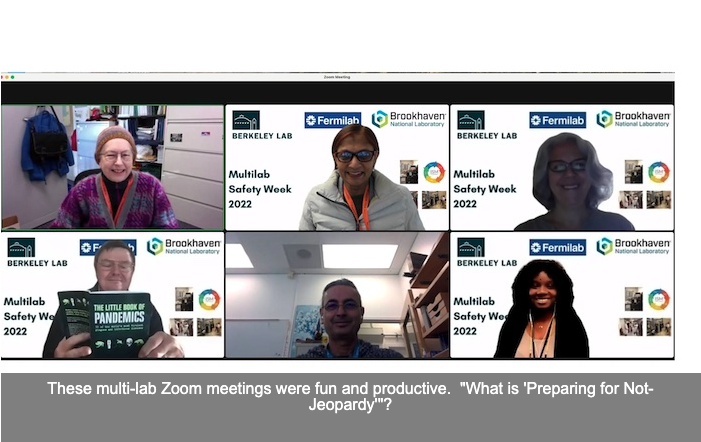

Clockwise from top left: Shown in one of their numerous Zoom meetings leading up to Multilab Safety Week are ATAP EH&S Coordinator Pat Thomas, ATAP Deputy Division Director for Operations Asmita Patel, Fermilab EH&S Professional Amy Pavnica, and Brookhaven Magnet Division EHS Coordinator Marteenio Samms, key organizers of the event
Besides extensive physical clean-up of labs, shops, and offices, Multilab Safety Week 2022 comprised a series of seminars and management walk-arounds that focused on opportunities for eliminating, minimizing, and re-using/recycling waste materials and equipment. On Monday, October 31, 2022, over 300 attendees from the three national labs participated in kick-off meetings launching the event.

L-R: Andrew Peterson, Edward Sierra, and Angela Aparicio
On Tuesday, November 1, 2022, Andrew Peterson (Berkeley Lab), Edward Sierra (BNL), and Angela Aparicio (Fermilab) co-presented a seminar on the processes, procedures, and responsibilities underpinning the Occurrence Reporting and Processing System (ORPS). The seminar was attended by over 200 participants, who learned about the importance of capturing safety events in the ORPS.

L-R: Melanie Alexandre, Michael Kincaid, Fred Horn, Amy Pavinca, and David Cathey
The focus turned to material handling on Wednesday, November 2, 2022, with Melanie Alexandre and Michael Kincaid of Berkeley Lab, Fred Horn from Brookhaven, and Amy Pavnica and David Cathey of Fermilab delivering a seminar entitled “Material Handling and Ergonomics.” The seminar covered the correct way to handle materials, highlighted some key handling statistics, conveyed lessons learned from Berkeley Lab, and also shared tips and resources from the ergo.lbl.gov website.
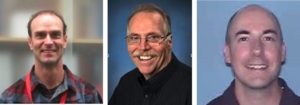
L-R: Kurt Ettinger, Michael Clancy, Robert Bushek
Attendance was strong again on Thursday, November 3, 2022, with over 200 attendees hearing from Kurt Ettinger (Berkeley Lab), Michael Clancy (Brookhaven), and Robert Bushek (Fermilab), who provided their perspectives on the proper Personal Protective Equipment to use when working in labs and shops.
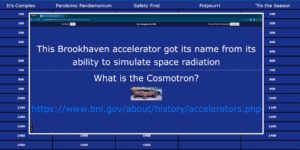
The essence of safety: not jeopardy

Greatest Of All Time at removing light fuels from steep hillsides… adorably. [Kelly Owen/Berkeley Lab]
Closing out the week, LBNL’s Asmita Patel, Patricia Thomas, and Joe Chew co-hosted “Not Jeopardy” on Friday. The game provided the over 150 participants with a fun opportunity to test their safety knowledge and to learn more about their sister labs: who knew, for example, that goats are employed as an effective wildfire prevention measure in the steep terrain of the Berkeley hills? Not Jeopardy was more than just a trivia game — it was a great team building event.
Best wishes for a happy and safe Thanksgiving holiday
Follow us on social media



